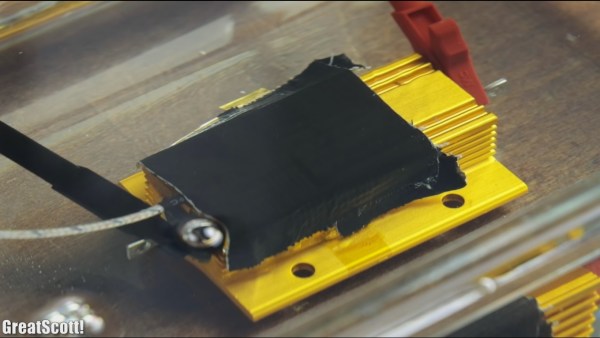Transformer oil has long served two purposes, cooling and insulating. The large, steel encased transformers we see connected to the electrical grid are filled with transformer oil which is circulated through radiator fins for dumping heat to the surrounding air. In the hacker world, we use transformer oil for cooling RF dummy loads and insulating high voltage components. [GreatScott] decided to do some tests of his own to see just how good it is for cooling circuits.
 He started with testing canola oil but found that it breaks down from contact with air and becomes rancid. So he purchased some transformer oil. First, testing its suitability for submerging circuits, he found that he couldn’t see any current above his meter’s 0.0 μA limit when applying 15 V no matter how close together he brought his contacts. At 1 cm he got around 2 μA with 230 VAC, likely from parasitic capacitance, for a resistance of 115 Mohm/cm.
He started with testing canola oil but found that it breaks down from contact with air and becomes rancid. So he purchased some transformer oil. First, testing its suitability for submerging circuits, he found that he couldn’t see any current above his meter’s 0.0 μA limit when applying 15 V no matter how close together he brought his contacts. At 1 cm he got around 2 μA with 230 VAC, likely from parasitic capacitance, for a resistance of 115 Mohm/cm.
Moving on to thermal testing, he purchased a 4.7 ohm, 100 watt, heatsink encased resistor and attached a temperature probe to it with Kapton tape. Submerging it in transformer oil and applying 25 watts through it continuously, he measured a temperature of 46.8°C after seven minutes. The same test with distilled water reached 35.3°C. Water’s heat capacity is 4187 J/kg∙K, not surprisingly much better than the transformer oil’s 2090 J/kg∙K which in turn is twice as good as air’s 1005 J/kg∙K.
He performed a few more experiments but we’ll leave those to his video below.
We’ve run across a number of tests running boards submerged in various oils before. For example, we’ve seen Raspberry Pi’s running in vegetable oil and mineral oil as well as an Arduino running in a non-conductive liquid coolant, all either overclocked or under heavy load.
Continue reading “Measuring The Cooling Effect Of Transformer Oil”












